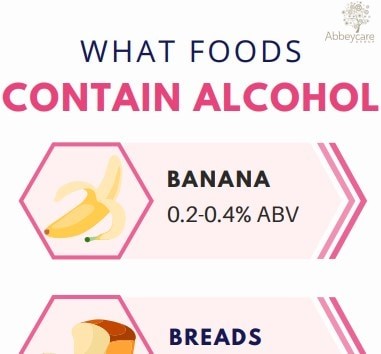It’s common knowledge that alcoholic beverages like beer, wine, and spirits contain ethanol. However, ethanol, also known as ethyl alcohol, can be found in unexpected places – your everyday food. Understanding What Foods Contain Ethanol and why can be crucial, especially for individuals with specific dietary restrictions or health concerns. Let’s dive into this topic.
Hidden Ethanol in Your Pantry: Common Culprits
While it might be surprising, many common foods naturally contain small amounts of alcohol due to fermentation. This is a natural process where yeasts or bacteria convert sugars into ethanol and carbon dioxide. Here are some examples:
- Ripe and Very Ripe Bananas: As bananas ripen, their starch converts to sugar, which then ferments. Ripe bananas can contain between 0.2% and 0.4% ABV (alcohol by volume).
- Breads: Most breads, especially those leavened with yeast, contain trace amounts of alcohol (between 1.18-1.28% ABV). This is because the yeast consumes sugars in the dough, producing carbon dioxide (which makes the bread rise) and ethanol. Burger rolls and rye bread are examples.
- Fruit and Fruit Juices: Fruits like grapes, oranges, and apples naturally contain sugars that can ferment, resulting in alcohol levels between 0.04% and 0.5% ABV. The alcohol content increases as the fruit or juice sits over time.
- Yogurt and Kefir: These fermented dairy products contain alcohol (0.05-2% ABV) due to the microorganisms that feed off lactose, the natural sugar in milk.
- Kombucha and Must: Kombucha, a fermented tea, and must, freshly crushed fruit juice, can have higher alcohol content (0.5-5% ABV) due to their fermentation processes.
- Vinegars: Vinegars like balsamic, champagne, sherry, and wine vinegar contain small amounts of alcohol (0.1-0.4% ABV) as they are derived from alcoholic liquids.
- Food Additives: Extracts and flavorings, such as vanilla or almond extract, can contain up to 35% ABV.
- Condiments: Some condiments, like mustard and soy sauce, contain alcohol (1.5-2% ABV) due to fermentation processes during their production.
- Soft Drinks: Some soft drinks may contain up to 0.5% ABV, possibly due to the use of ethanol as a carrier for flavorings.
Why Ethanol is Present in These Foods
Ethanol production in food is primarily a result of fermentation. Yeasts (in bread) or bacteria (in fruit) interact with sugars, leading to spontaneous fermentation. During this process, the sugar is broken down into ethanol and carbon dioxide. The amount of alcohol generated depends on the type of food, the microorganisms involved, and the duration of fermentation.
Considerations and Concerns
For most people, the trace amounts of alcohol in these foods are negligible and pose no health risk. However, individuals with specific conditions or concerns may need to be more cautious:
- Alcohol Sensitivity or Allergy: People with alcohol sensitivities or allergies may experience reactions to even small amounts of ethanol.
- Medications: Certain medications can interact with alcohol, so it’s important to be aware of potential sources.
- Religious or Personal Beliefs: Some individuals avoid alcohol for religious or personal reasons, regardless of the amount.
- Auto-Brewery Syndrome: Though rare, individuals with auto-brewery syndrome produce ethanol in their digestive system after consuming carbohydrates.
- Children: Large volumes of fruit juice, for instance, may affect children more due to their lower body weight.
Minimizing Ethanol Intake from Food
If you’re concerned about the ethanol content in your food, here are some tips:
- Choose Fresh, Whole Foods: Opt for fresh, unprocessed foods like vegetables, sprouted seeds, whole grains, legumes, nuts, and meat protein sources.
- Avoid Overripe Fruits: Eat fruits before they become overly ripe, as the alcohol content increases with ripeness.
- Limit Fermented Foods: Reduce your intake of fermented foods like yogurt, kefir, kombucha, and sauerkraut.
- Read Labels Carefully: Check the labels of condiments, extracts, and flavorings for alcohol content.
- Cook Thoroughly: When cooking with alcohol-containing ingredients, remember that prolonged heating can reduce the alcohol content. Cooking or baking for at least 3 hours can minimize residual alcohol.
- Stay Hydrated: Drinking enough water helps your body eliminate toxins, including alcohol.
The Bottom Line
While the presence of ethanol in certain foods may seem surprising, the amounts are generally low and pose little risk for most people. By understanding which foods contain ethanol and why, you can make informed choices to align with your dietary needs and preferences. For those with specific health concerns or sensitivities, being mindful of these hidden sources of alcohol is key.
References
[1] https://www.ncbi.nlm.nih.gov/pmc/articles/PMC7468834/
[2] https://www.fsai.ie/faq/alcohol.html
[3] https://www.fda.gov/food/food-additives-petitions/food-additives-permitted-use
[4] https://www.ncbi.nlm.nih.gov/pmc/articles/PMC6826849/
[5] https://pubmed.ncbi.nlm.nih.gov/2231311/
[6] https://www.webmd.com/diet/foods-contain-alcohol
[7] https://www.sciencedirect.com/topics/agricultural-and-biological-sciences/fermented-food
[8] https://www.poison.org/articles/can-you-get-drunk-from-eating-too-many-ripe-bananas
[9] https://www.hsph.harvard.edu/nutritionsource/fruit/
[10] https://www.health.harvard.edu/staying-healthy/the-gut-microbiome-and-health

